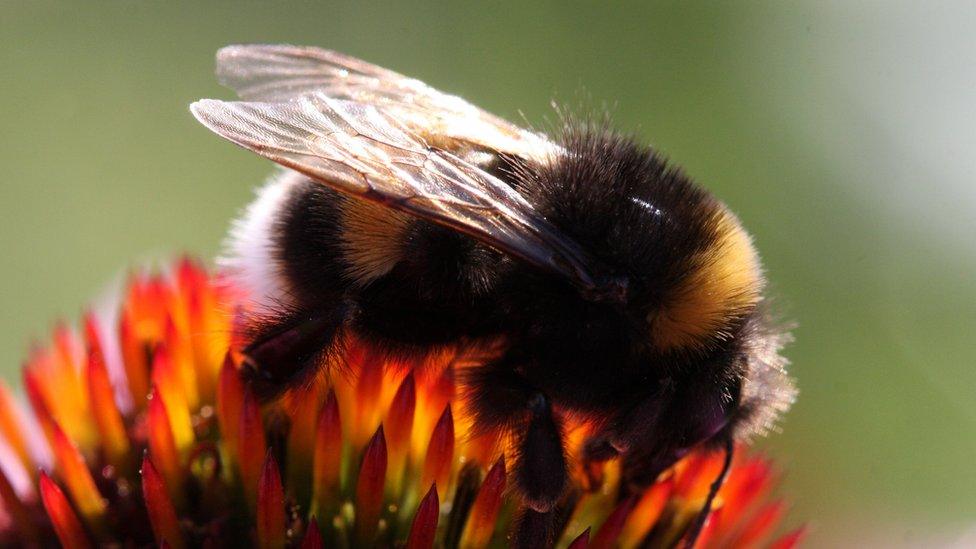Banned pesticides 'not equally harmful' to bees
- Published

The largest field study so far in to the group of pesticides called "neonicotinoids" has concluded that each acts differently on the brains of the bees.
One of the chemicals widely considered as being the most toxic wasn't shown to affect bees at a level found in the countryside.
However other "neonics" were shown to cause significant harm to bumblebees.
The results of the study are published in the journal Scientific Reports.
This study examined the three types banned by the EU in 2013. It shows that different types affect the brains of bumblebees in distinct ways.
Two (imidacloprid and thiamethoxam) were shown to be highly toxic to bumblebees when they were exposed to levels of the chemicals found in the countryside.
They affected their brains, impairing their memory and ability to forage for pollen. The toxic effects also included altering the make-up of the colony, changing the ratio of males to females and in some cases reducing the number of queens.
The third (clothiandin) - a close chemical relative that has not been tested before is shown not to be harmful to bees in the low doses given during field trials. The number of queens in the colonies actually increased.
'Long-term consequences'
Dr Chris Connolly, from the University of Dundee, said: "There has been growing concern over the risk to bee populations from neonicotinoid insecticides and their long-term consequences to essential ecosystem services and food security."
He said: "We can clearly see that the banned neonicotinoids are not the same, so they should be considered independently when considering risk and legislation.
"From our findings, we consider that it is premature to place a permanent ban on the use of clothianidine. That said, a moratorium on its use should continue until the knowledge gaps are filled on its wider impact on other species."
This data was gathered from what the researchers say is the largest field trial of its kind. They established 75 colonies at five different sites in Scotland. Almost no insecticides were being used in nearby farmland.
The bees were isolated in boxes and given an untreated sugar solution containing the neonics. They assessed the progress of the colonies over five weeks between June and September last year by counting and weighing the bees.
Dr Mike Garratt, an ecologist at the Centre for Agri-Environmental Research at the University of Reading, said: "This is an important and timely study. As the body of evidence for negative effects of neonicotinoids on non-target species mounts, it is important to consider the differential effects of these chemicals and this new research clearly demonstrates not all are equally harmful.
"This work once more highlights the clear evidence gaps regarding the wider effect of this type of insecticide.
"Much more work needs to be done if these serious policy decisions, with wide-ranging impacts on our food supply and environment, are to be based on the best scientific evidence."
Dr Peter Campbell works for Syngenta, which manufactures and sells the neonicotinoid thiamethoxam.
He commented: "It is important to note that the colony studies were conducted by directly feeding colonies with spiked sucrose, which is not representative of exposure of wild bumblebees under normal field conditions.
"The colony level results reported from these studies are also inconsistent with other reported colony studies with bumblebees."
Paul de Zylva, from green campaign group Friends of the Earth, said: "This study confirms that two of the restricted pesticides are harmful to bees.
"But this latest research does not give a clean bill of health to the third, clothianidin. A number of other studies raise serious concerns about the impact of this pesticide on bees."
This report comes as the National Farmers Union (NFU) has applied for an exemption to the EU-wide ban on the insecticides.
Friends of the Earth wants the ban to remain in place, and for the government to reject the NFU's application.
Neonicotinoids are the most widely used insecticide in the world. They are deployed to kill a range of pests including aphids and grubs.
Follow Claire on Twitter., external